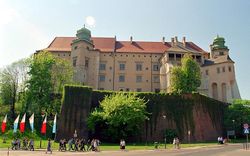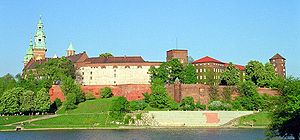
Wawel Hill
Encyclopedia
Wawel Hill is the name of a Jurassic
limestone outcrop formed about 150 million years ago. It is situated on the left bank of the Vistula River in Kraków
, Poland
, at an altitude of 228 metres above the sea level. Over the millennia, the hill provided a safe haven for people who settled there since the Paleolithic
Age. It is assumed that the Western Slavic
tribe of Lechitians (Poles
) started living on the Wawel Hill as early as the 7th century.
Wawel
is a symbolic place of great significance for all Polish people. The Royal Castle
and the Cathedral
are situated on the Hill. Polish Royalty and many distinguished Poles are interred in the Basilica. Royal coronations
have taken place there since 1320.
 Archaeological artifacts from the Wawel Hill, then surrounded by marshes, indicate an early settlement from the 7th century. Towards the end of the first millennium AD, Wawel began to play a role as the centre of political power.
Archaeological artifacts from the Wawel Hill, then surrounded by marshes, indicate an early settlement from the 7th century. Towards the end of the first millennium AD, Wawel began to play a role as the centre of political power.
The first historical ruler Mieszko I of Poland
(c.965-992) of the Piast dynasty
as well as his successors: Boleslaw I the Brave
and Mieszko II
(1025–1034) chose Wawel Hill as one of their residences. The history of the medieval Wawel is deeply intertwined with the history of the Polish lands and Polish royal dynasties during the Middle Ages
. The political and dynastic history that led to the ascendence of Kraków
as the royal capital are complex, but for most of the Middle Ages and the Renaissance
the Wawel Hill remained the seat of national government. As the Polish-Lithuanian Commonwealth
formed and grew, Wawel
became the seat of one of Europe's most important states. This status was only lost when the capital was moved to Warsaw
in the 17th century. Subsequently, when Poland lost its independence to foreign powers during the period of partitions
, Wawel became the symbol of national survival; demonstrations and meetings combined contemporary political action with remembrance of the significance of the once-independent state.
 The pivotal role of the Wawel Hill for Poland comes from the combination of political and religious structures and functions associated with it. The Cathedral holds the relics of St. Stanisław
The pivotal role of the Wawel Hill for Poland comes from the combination of political and religious structures and functions associated with it. The Cathedral holds the relics of St. Stanisław
and stands directly adjacent to the Royal Castle. The Hill has long had a religious function; some of the oldest extant architectural remains are those of the Rotunda of the Virgin Mary, which may be visited today in a fascinating tour that takes the visitors into the walls and foundations of the present-day buildings.
Jurassic
The Jurassic is a geologic period and system that extends from about Mya to Mya, that is, from the end of the Triassic to the beginning of the Cretaceous. The Jurassic constitutes the middle period of the Mesozoic era, also known as the age of reptiles. The start of the period is marked by...
limestone outcrop formed about 150 million years ago. It is situated on the left bank of the Vistula River in Kraków
Kraków
Kraków also Krakow, or Cracow , is the second largest and one of the oldest cities in Poland. Situated on the Vistula River in the Lesser Poland region, the city dates back to the 7th century. Kraków has traditionally been one of the leading centres of Polish academic, cultural, and artistic life...
, Poland
Poland
Poland , officially the Republic of Poland , is a country in Central Europe bordered by Germany to the west; the Czech Republic and Slovakia to the south; Ukraine, Belarus and Lithuania to the east; and the Baltic Sea and Kaliningrad Oblast, a Russian exclave, to the north...
, at an altitude of 228 metres above the sea level. Over the millennia, the hill provided a safe haven for people who settled there since the Paleolithic
Paleolithic
The Paleolithic Age, Era or Period, is a prehistoric period of human history distinguished by the development of the most primitive stone tools discovered , and covers roughly 99% of human technological prehistory...
Age. It is assumed that the Western Slavic
West Slavs
The West Slavs are Slavic peoples speaking West Slavic languages. They include Poles , Czechs, Slovaks, Lusatian Sorbs and the historical Polabians. The northern or Lechitic group includes, along with Polish, the extinct Polabian and Pomeranian languages...
tribe of Lechitians (Poles
Poles
thumb|right|180px|The state flag of [[Poland]] as used by Polish government and diplomatic authoritiesThe Polish people, or Poles , are a nation indigenous to Poland. They are united by the Polish language, which belongs to the historical Lechitic subgroup of West Slavic languages of Central Europe...
) started living on the Wawel Hill as early as the 7th century.
Wawel
Wawel
Wawel is an architectural complex erected over many centuries atop a limestone outcrop on the left bank of the Vistula River in Kraków, Poland, at an altitude of 228 metres above the sea level. It is a place of great significance to the Polish people. The Royal Castle with an armoury and the...
is a symbolic place of great significance for all Polish people. The Royal Castle
Wawel Castle
The Gothic Wawel Castle in Kraków in Poland was built at the behest of Casimir III the Great and consists of a number of structures situated around the central courtyard. In the 14th century it was rebuilt by Jogaila and Jadwiga of Poland. Their reign saw the addition of the tower called the Hen's...
and the Cathedral
Wawel Cathedral
The Wawel Cathedral, also known as the Cathedral Basilica of Sts. Stanisław and Vaclav, is a church located on Wawel Hill in Kraków–Poland's national sanctuary. It has a 1,000-year history and was the traditional coronation site of Polish monarchs. It is the Cathedral of the Archdiocese of Kraków...
are situated on the Hill. Polish Royalty and many distinguished Poles are interred in the Basilica. Royal coronations
Royal coronations in Poland
Royal coronations in Poland officially began in 1025 and continued until 1764, when the final King of an independent Poland, Stanisław August Poniatowski, was crowned at St. John's Cathedral in Warsaw. Most Polish coronations took place at the Wawel Cathedral in Kraków, but crownings also occurred...
have taken place there since 1320.
History

The first historical ruler Mieszko I of Poland
Mieszko I of Poland
Mieszko I , was a Duke of the Polans from about 960 until his death. A member of the Piast dynasty, he was son of Siemomysł; grandchild of Lestek; father of Bolesław I the Brave, the first crowned King of Poland; likely father of Świętosława , a Nordic Queen; and grandfather of her son, Cnut the...
(c.965-992) of the Piast dynasty
Piast dynasty
The Piast dynasty was the first historical ruling dynasty of Poland. It began with the semi-legendary Piast Kołodziej . The first historical ruler was Duke Mieszko I . The Piasts' royal rule in Poland ended in 1370 with the death of king Casimir the Great...
as well as his successors: Boleslaw I the Brave
Boleslaw I of Poland
Bolesław I Chrobry , in the past also known as Bolesław I the Great , was a Duke of Poland from 992-1025 and the first King of Poland from 19 April 1025 until his death...
and Mieszko II
Mieszko II Lambert
Mieszko II Lambert was King of Poland during 1025–1031, and Duke from 1032 until his death.He was the second son of Bolesław I the Brave, but the eldest born from his third wife Emmilda, daughter of Dobromir, possible ruler of Lusatia. He was probably named after his paternal grandfather, Mieszko I...
(1025–1034) chose Wawel Hill as one of their residences. The history of the medieval Wawel is deeply intertwined with the history of the Polish lands and Polish royal dynasties during the Middle Ages
Middle Ages
The Middle Ages is a periodization of European history from the 5th century to the 15th century. The Middle Ages follows the fall of the Western Roman Empire in 476 and precedes the Early Modern Era. It is the middle period of a three-period division of Western history: Classic, Medieval and Modern...
. The political and dynastic history that led to the ascendence of Kraków
Kraków
Kraków also Krakow, or Cracow , is the second largest and one of the oldest cities in Poland. Situated on the Vistula River in the Lesser Poland region, the city dates back to the 7th century. Kraków has traditionally been one of the leading centres of Polish academic, cultural, and artistic life...
as the royal capital are complex, but for most of the Middle Ages and the Renaissance
Renaissance
The Renaissance was a cultural movement that spanned roughly the 14th to the 17th century, beginning in Italy in the Late Middle Ages and later spreading to the rest of Europe. The term is also used more loosely to refer to the historical era, but since the changes of the Renaissance were not...
the Wawel Hill remained the seat of national government. As the Polish-Lithuanian Commonwealth
Polish-Lithuanian Commonwealth
The Polish–Lithuanian Commonwealth was a dualistic state of Poland and Lithuania ruled by a common monarch. It was the largest and one of the most populous countries of 16th- and 17th‑century Europe with some and a multi-ethnic population of 11 million at its peak in the early 17th century...
formed and grew, Wawel
Wawel
Wawel is an architectural complex erected over many centuries atop a limestone outcrop on the left bank of the Vistula River in Kraków, Poland, at an altitude of 228 metres above the sea level. It is a place of great significance to the Polish people. The Royal Castle with an armoury and the...
became the seat of one of Europe's most important states. This status was only lost when the capital was moved to Warsaw
Warsaw
Warsaw is the capital and largest city of Poland. It is located on the Vistula River, roughly from the Baltic Sea and from the Carpathian Mountains. Its population in 2010 was estimated at 1,716,855 residents with a greater metropolitan area of 2,631,902 residents, making Warsaw the 10th most...
in the 17th century. Subsequently, when Poland lost its independence to foreign powers during the period of partitions
Partitions of Poland
The Partitions of Poland or Partitions of the Polish–Lithuanian Commonwealth took place in the second half of the 18th century and ended the existence of the Polish–Lithuanian Commonwealth, resulting in the elimination of sovereign Poland for 123 years...
, Wawel became the symbol of national survival; demonstrations and meetings combined contemporary political action with remembrance of the significance of the once-independent state.

Stanislaus of Szczepanów
Stanislaus of Szczepanów, or Stanisław Szczepanowski, was a Bishop of Kraków known chiefly for having been martyred by the Polish king Bolesław II the Bold...
and stands directly adjacent to the Royal Castle. The Hill has long had a religious function; some of the oldest extant architectural remains are those of the Rotunda of the Virgin Mary, which may be visited today in a fascinating tour that takes the visitors into the walls and foundations of the present-day buildings.

